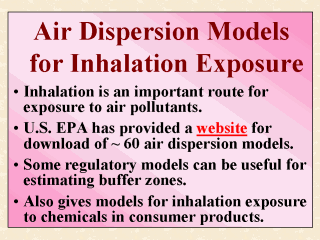| front |1 |2 |3 |4 |5 |6 |7 |8 |9 |10 |11 |12 |13 |14 |15 |16 |17 |18 |19 |20 |21 |22 |23 |24 |review |

|
Dermal uptake
and dietary intake are not the only pathways of concern to the regulatory agencies.
Inhalation is an important route for exposure to air pollutants. Partly due to the Clean
Air Act, many programs in the USA have been developed to model air dispersion. U.S. EPA
(2000c) has provided a website where currently about 60 air quality models can be
downloaded. Of these downloadable, nearly one-third are regulatory models. Both the Industrial Source Complex Short-term (ISCST) and Long-term (ISCLT) Models are regulatory programs designed to simulate off-site air levels based on flux values and weather conditions. Flux data measure the emissions of a contaminant from soil or other sources. Emissions of this type are assumed to be proportional to soil concentration, and the air dispersion is expected to be weather-dependent. Both the ISCST and the ISCLT models thus appear to be very useful for establishing buffer zones for residents living near fields treated with soil fumigants or the like. Buffer zones are distances added to the edge of a treated field by regulation, in an effort to ensure that beyond that boundary (away from the treated site) the air concentrations at or after the specified time period would be below the level of health concern. For inhalation of chemicals in consumer products, U.S. EPA (1994) has developed the Screening Consumer Inhalation Exposure Software (SCIES) to facilitate the required calculations. This model classifies consumer products into 11 categories, and calculates first-tier estimates of average individual inhalation potential dose rates to components of the classified products. |